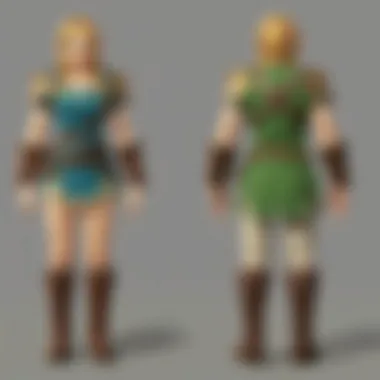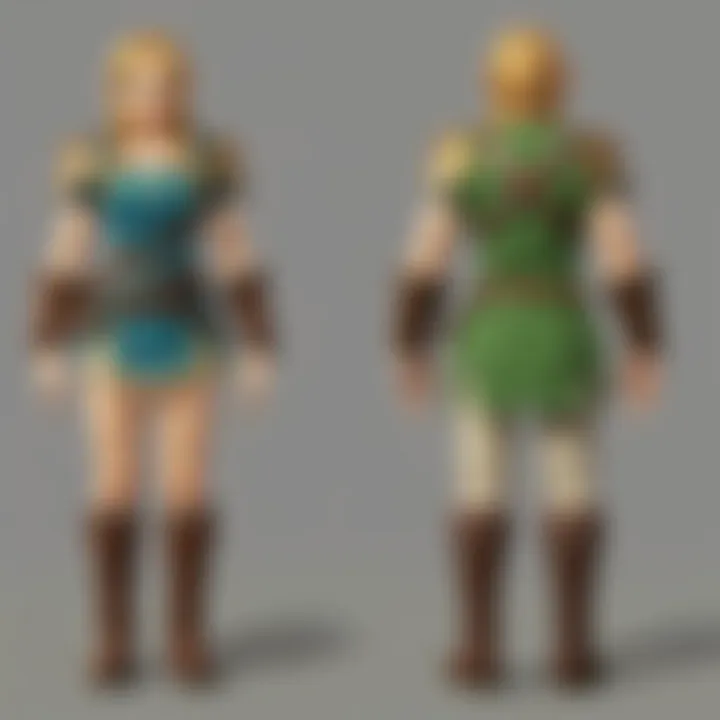Quest Talk Line: Analyzing Dialogue in Zelda Games


Intro
The Zelda series has crafted a world that resonates with players, immersing them in a rich narrative filled with intriguing characters and engaging quests. A vital component of this intricate tapestry is the quest talk line, which serves as a bridge between the player and the game’s universe. By examining the dialogue woven throughout the series, one can unravel the threads that connect gameplay, storytelling, and the characters’ development.
Through the lens of the quest talk line, this exploration highlights the importance of dialogue in not just conveying information but also in shaping the emotional landscape of the game. The conversations, whether between Link and a fairy or between rival heroes, illuminate the lore and deepen the players' experience, creating an intimate connection with the world of Zelda.
Game Reviews
Gameplay Features and Mechanics
At the heart of each Zelda title lies a unique gameplay experience characterized by intricate mechanics and engaging systems. The quest talk line enhances these features by providing context, allowing players to grasp the significance of their actions in the grand scheme of their adventure. For instance, the characters’ hints about upcoming challenges or treasures play a crucial role in steering players towards strategic thinking. It’s not simply about what to do next but understanding why it matters within the larger narrative.
- Interactivity: How players engage with NPCs often influences their quest trajectory.
- Hints and Guidance: Dialogue frequently serves as a way to inform players of mechanics they might overlook.
- Narrative Depth: Each interaction unfolds layers of story that enrich the game's experience.
Storyline and Quests
The quest talk line is pivotal in shaping the overarching storyline throughout the Zelda franchise. It allows for an exploration of complex themes such as bravery, sacrifice, and the eternal battle between good and evil. Characters often share legends or anecdotes that connect to the lore, enhancing players' comprehension of their journey.
For example, in The Legend of Zelda: Breath of the Wild, conversations about the calamity that befell Hyrule and the backstories of the champions contextualize players' missions. This narrative device effectively brings forth the emotional stakes involved, making the quests feel consequential rather than mere chores in a game.
Visuals and Sound Design
The dialogue in Zelda isn’t just about spoken words—it's woven into the very fabric of its visuals and sound design. The character animations match the tone of their speech, providing cues that guide player emotions. Whether it's the warmth of a cheerful villager or the strain in a warrior's voice recounting a tragic tale, the synergy between visuals, sound, and dialogue creates a fully engaging experience. This is particularly evident during pivotal story moments, where every line, look, and tone adds weight to the encounter.
Comparison with Previous Titles
Each title in the series has offered its take on quest dialogue, evolving with technology and storytelling methods. Take The Legend of Zelda: Ocarina of Time—the dialogue served a more straightforward function, focusing primarily on quest progression. In contrast, Breath of the Wild expanded on this foundation, allowing for a broader range of interactions that affected gameplay profoundly.
"The conversations in modern Zelda titles create a ebb and flow that complements gameplay, transforming mere tasks into meaningful journeys."
By comparing these aspects across titles, players can appreciate how dialogue has developed from just being a mechanic to a tool that enhances player immersion.
Character Analyses
Popular Characters Overview
The characters in Zelda are more than just figures occupying Hyrule; they embody the essence of the narrative. Each character’s interaction, their dialogue, reveals insights into their motivations and conflicts, providing depth beyond their quests.
Some key characters include:
- Link: The silent protagonist whose reactions are often conveyed through others.
- Zelda: Represents wisdom and courage, often offering guidance through her words.
- Ganon: Embodies darkness, with dialogue that reflects his ambitions and failures.
Character Development and Backstories
As players embark on their quests, the dialogues often unveil character backstories which enrich the gameplay. Whether it's Zelda detailing her lineage or a merchant sharing tales of lost relics, these interactions create a narrative web that links character motivations to player actions.
Role in the Zelda Universe
The quest talk lines intricately tie characters to the world of Zelda. Each character stands as a symbol of various themes present throughout the series. Their dialogues often act as lighthouses, guiding players through moral dilemmas and historical contexts embedded deep within the lore.
Fan Theories and Speculations
Players often engage in discussions that speculate on the implications of dialogue, potentially igniting fascinating theories about the lore. These theories add another layer of engagement as players hypothesize about the broader implications of a character's actions or statements within the series. This dialogic exchange among the community can, in turn, illuminate collective understanding of the game’s deeper meanings.
Lore Discussions
Mythology and Worldbuilding
The dialogue in Zelda serves not just to entertain but to provide rich details within the mythology of the universe. Characters often discuss historical events, legends, and important artifacts, allowing players to uncover the layers of worldbuilding that the developers meticulously crafted. This lends to a sense of history that enhances immersion.
Legendary Items and Artifacts
Many quests hinge on acquiring legendary items, and the dialogue surrounding these artifacts often holds clues about their significance or the trials one must undergo to wield them. Familiarity with this dialogue can mean the difference between a smooth adventure and a frustrating trial and error approach.
Link to Real-world Mythologies
The Zelda series draws heavily from real-world mythologies, and this is evident in its quest dialogue. Many characters reference tales and beliefs that echo myths from various cultures. Understanding these parallels not only enriches gameplay but also offers fascinating insights into the narrative's inspirations.
Timeline Placement and Theories
With the Zelda series spanning multiple timelines, dialogue often serves to indicate where a specific title fits within the overarching narrative. The conversations can lead players to ponder connections between events and characters, fostering discussions on timeline theories.
Gameplay Strategies
Combat Techniques and Tips
Understanding the nuances of combat often relies on dialogue that hints at enemy weaknesses or strategies. For instance, a character mentioning a monster's vulnerability to fire might be the key to winning a challenging encounter.


Puzzle Solutions and Walkthroughs
Quest dialogues can drop clues about puzzle-solving or hidden locations. Paying attention to the subtleties in conversations can save time and lead to unimagined treasures.
Collectibles and Side Quest Guides
Many side quests also hinge heavily on dialogue. Conversations can reveal not just the location of collectibles but insight into why they're worthwhile—a narrative boon that enhances their significance.
Boss Battles Tactics and Strategies
Boss fights are often climactic, and the lead-up dialogue can provide hints or even foreshadow tactics required to defeat them. Engaging with NPCs before a significant battle can help prepare players for the crescendo that awaits.
Each section of this deep dive showcases the critical role that quest talk lines encompass in creating an engaged, narrative-rich environment that Zelda fans have cherished for decades. By analyzing characters, mechanics, and lore, it becomes abundantly clear how dialogue transforms an ordinary gaming experience into one filled with emotion and resonance.
Understanding Quest Talk Lines
The world of Zelda is rich, vibrant, filled with tales of bravery, friendship, and challenges that captivate players. At the heart of these tales lies the concept of quest talk lines. This article aims to explore this topic, highlighting its importance in the Zelda universe while delving into how dialogue shapes the gaming experience.
Understanding quest talk lines isn’t just about the words spoken; it’s about grasping the narrative undercurrents that these lines create. Through dialogue, characters express their motivations, fears, and aspirations, facilitating players' immersion into this fantastical realm. Players are not just passive observers; they become participants in a living story, making choices influenced by the conversations they engage in.
In an era where narrative is as vital as gameplay mechanics, quest talk lines serve as the connective tissue between the player and the game's lore. We will explore how dialogue invites players to delve deeper into character backstories, enhances the stakes of quests, and makes the world feel lived-in. It’s about creating an atmosphere where each interaction adds layers of depth to the plot.
Defining the Concept
Quest talk lines are the scripted dialogues that characters engage in during quests. These lines are more than mere exchanges; they encapsulate emotional motifs and elaborate layers to the plot. Think of Link, the silent protagonist, whose reactions stem from those around him. Each character he encounters has their unique perspective, flavoring the storyline with rich context and dialogue that resonates with players.
For instance, a character might say, "You need courage, not just in battle, but in heart," highlighting not only what Link must do but also reinforcing the themes of bravery and self-discovery pervasive throughout Zelda's narratives. Such lines forge connections, transcending mere gameplay mechanics to evoke feelings of attachment to characters and their journeys.
Historical Context in Game Design
The role of quest talk lines in games isn't a new concept. Historically, dialogue has evolved, moving from simplistic text to complex interactions that mirror real-life conversations. In early video games, dialogues were often limited and rarely contributed significantly to the narrative. However, as technology advanced, so did the expectations surrounding storytelling.
In Zelda, the evolution of quest talk lines can be traced from the straightforward exchanges in "The Legend of Zelda" (1986) to the intricate web of dialogues found in more recent titles like "Breath of the Wild" (2017).
Just as a fine wine matures over time, the dialogue reflecting rich emotional subplots has come to enhance the gaming experience profoundly. Quest lines now serve not only as markers of progression but as vessels transporting players into the very essence of the narrative arc. Every chat offers hints, motives, or lore, beckoning players to listen and engage entirely, turning every interaction into an exploration of Zelda’s universe.
The significance of understanding quest talk lines stems from recognizing their narrative weight. They encapsulate histories, character motivations, and interaction dynamics within the expansive Zelda universe. By appreciating these elements, players can derive a richer, more meaningfull experience.
Narrative Functionality
In the realm of video games, particularly within the expansive Zelda universe, the narrative functionality of quest talk lines serves as the backbone of storytelling and player immersion. Quest talk lines do not merely provide players with objectives; they are intricate threads that weave together various elements of the game’s lore, characters, and world. This segment focuses on how these dialogues enhance the narrative experience, anchoring players deeper into the plot and enriching their emotional journey as they navigate through Hyrule.
Building the Story
When considering the essence of a well-crafted narrative in gaming, one cannot overlook the pivotal role of quest dialogues in shaping the storyline. In The Legend of Zelda: Breath of the Wild, for instance, NPCs, or non-player characters, sprinkle hints and lore that catapult players toward understanding the backstory of the kingdom. Conversing with characters like the enigmatic Impa or the wise Master Koga provides players with not just tasks to complete but also the context needed to grasp the histories that bind the protagonist, Link, with the world around him.
These interactions drive home the idea that dialogue is more than mere words; it is the vehicle through which narrative depth is delivered. In settings like Hyrule, where time is woven into the fabric of the story, past events influence current quests. By facilitating this connection, quest talk lines act as gateways that fortify the player’s comprehension of the overarching narrative, ensuring they are not lost in mechanical objectives but are instead fully encompassed in the story.
Character Development Through Dialogue
Character evolution is as vital as the quests themselves. Zelda serves not just as a beautiful princess in need of rescue but as a complex character whose dialogues unveil her growth, choices, and aspirations. For instance, her sparse yet poignant exchanges with Link in The Legend of Zelda: Twilight Princess reflect the challenges she faces, showcasing a blend of vulnerability and strength. Such interactions encourage players to connect with her not only as a prize but as a companion on this grand adventure.
Contrary to traditional game tasks, each dialogue adds a layer of character development, revealing motivations and desires, thereby captivating the players. As Link interacts with various characters, their responses and the way they perceive him also shape his persona, creating a rich tapestry of relationships that pulls the player further into the saga.
Creating Emotional Impact
In a universe often perceived as whimsical and fantastical, the emotional weight of quest talk lines cannot be overstated. The dialogues have the ability to induce a spectrum of sentiments, from joy and wonder to despair and loss. Take, for example, the heart-wrenching moments in The Legend of Zelda: Ocarina of Time, where the haunting words exchanged between Link and his childhood friend Saria invoke a profound sense of nostalgia and longing. It highlights that gamers are not merely spectators but become intertwined with the emotional landscape of the characters.
"Every quest line is a thread in the fabric of Hyrule’s story, capable of invoking real emotions and reflections within the player!"
The emotional resonance created through the narrative choices players make, and how they affect character relationships, is palpable. It bridges the gap between the virtual and the real, allowing players to reflect on their own life experiences through the lens of the quests they undertake. This intertwining of personal emotion and narrative is what elevates the Zelda experience from gaming to something akin to storytelling artistry, pulling players into a deeper narrative journey with every line of dialogue.
Gameplay Mechanics
In the realm of the Zelda franchise, gameplay mechanics serve as a backbone, architecting the very fabric of each adventure. These mechanics do not exist simply as features—they mold the player’s experience, crafting immersive narratives and dynamic interactions. Understanding how quest talk lines integrate with gameplay mechanics deepens our appreciation for this iconic series. Let’s unravel two crucial elements: quest initiation and progression, and choice and consequence in dialogue.
Quest Initiation and Progression
Quest initiation in the Zelda series often begins with a gleaming symbol: a character beckoning the hero towards an impending journey. When players engage in dialogue, they frequently trigger pivotal narratives that propel the game forward. The NPCs, or non-playable characters, serve as guides, each dialogue unveiling snippets of lore or hints to help in quest progression. A well-crafted quest talk line does more than direct actions; it tethers players to the storyline, making each quest feel organic rather than a mere checkbox on a to-do list.
Think about how Link’s dialogue often appears terse—like a whisper on a windy hill. This isn’t out of neglect; it’s a deliberate choice. By limiting verbal interactions for the protagonist, the game fosters a sense of immersion where the focus remains on the unfolding world and its myriad adventures. With every quest started through conversation, the narrative grows richer, waiting for players to dig deeper into its layers.
"A character's dialogue often symbolizes the key that unlocks the door to both the quest and the lore it entails."
In terms of progression, each dialogue choice influences how players perceive the quest’s urgency or importance. Characters often react to your actions, subtly sculpting the journey ahead. This interplay between dialogue and action engages players in a loop where every decision darkens or illuminates the path forward, making each choice feel weighty.
Choice and Consequence in Dialogue
Dialogue in the Zelda universe is far from static; it is dynamic—the choices players make resonate not just in the immediate moment but ripple throughout the game. One could say it’s like tossing a stone into a pond; the ripples affect the calm water in ways hard to predict.
In some titles, selecting how to respond to characters may lead to different outcomes, such as altering alliances or influencing the story’s direction. Players find themselves at a crossroads, pondering not only what they want to say but what their choices might signify. Through branching dialogues, the Zelda series infuses the narrative with layers of complexity.


Notably, consider the interactions with Zelda herself across different titles. Her responses often depend on Link’s dialogue choices, enhancing the richness of their relationship, consequently influencing the overarching storyline. In Breath of the Wild, for instance, players feel the weight of their choices, tapping into an emotional nuance that heightens the experience.
This intertwining of choice and consequence illustrates the thoughtful design behind these quest talk lines. Players are not mere observers; they are integral pieces of the game's narrative puzzle. The careful arrangement of dialogue serves to establish not only gameplay mechanics but also narrative stakes, making each gaming session uniquely personal.
As we explore more intricate facets of the Zelda universe, these mechanics underscore the importance of engaging with quest talk lines not just as a means to an end, but as a gateway into deeper engagement with the game.
Cultural Impact and Reception
Understanding the cultural impact and reception of quest talk lines within the Zelda universe highlights how deeply intertwined these dialogues are with both fan engagement and broader gaming culture. Quest talk lines serve as a lens through which players appreciate the narrative depth and artistic vision behind the games, fostering a rich environment for discussion and community interaction.
Fan Communities and Discussions
The essence of any iconic game series is often crystallized in its community. The Zelda fandom is no exception. Fans gather on platforms like Reddit and Facebook to reminisce about their favorite quest lines, dissecting dialogue that not only moves the plot forward but also reflects character growth. Discussions often verge on the philosophical, as players debate meaning and intention behind the words spoken by Link, Zelda, and their myriad of companions.
Specific quest lines from titles like Ocarina of Time or Breath of the Wild stand out not just for their gameplay but for the memorable dialogues that have become inside jokes or references in fan art. For instance, the repeated phrase "It’s dangerous to go alone! Take this!" has transcended its context, emerging in memes and fan content, reinforcing the saying within the larger context of gaming culture.
Moreover, these fan discussions have resulted in collaborative projects, where community members create elaborate lore theories or even fan-made translations of in-game scripts. This enhanced collective interpretation encourages deeper connections among fans.
Critical Analysis and Reviews
Critical reception of quest talk lines has evolved as gaming critique itself has matured. Early reviews often brushed aside dialogue as secondary to gameplay mechanics, but contemporary perspectives frequently recognize their narrative significance. Critics now analyze how dialogue choices can alter not just outcomes, but the very essence of character relationships and player agency.
Reviewers also comment on how different titles have approached dialogue differently. For instance, the shift from text-based dialogue in earlier games, like The Legend of Zelda, to fully voiced performances in modern titles signifies a major cultural shift. The transition allows for richer emotional experiences, though it has sparked discussions about fidelity to original narratives versus contemporary storytelling styles.
Additionally, reviews touch on how quest talk lines resonate with diverse audiences. Female characters, like Princess Zelda, are often scrutinized for their portrayal via dialogue—whether they reinforce or dismantle traditional roles. Much of the discourse emphasizes the importance of nuanced, sophisticated exchanges that contribute to character depth, rather than relegating female figures to mere plot devices.
In summary, the cultural impact and reception of quest talk lines are integral to understanding the overall influence of the Zelda series. Fan communities thrive on dialogue, creating connections, while critical analysis helps to elevate conversations about the narrative potential in gaming. This ongoing discourse not only enhances the appreciation of Zelda as a franchise but also establishes its place in the pantheon of video game storytelling.
Comparative Analysis Across Titles
The exploration of quest talk lines within the Zelda universe is not merely an academic pursuit; it serves to contextualize character interaction and narrative evolution against the backdrop of significant titles across the series. By engaging in a comparative analysis, one gains a holistic view of how dialogue not only enhances storytelling but also molds the gameplay experience in a manner akin to other legendary franchises.
Engaging in this topic, we unlock layers of depth that inform not just the games themselves but also the culture and community surrounding them. By spanning the various critical entries within the series, the dialogue and its impact on player immersion are placed under the microscope. This examination allows us to dissect the intricate fabric of the series, thus revealing the benefits and considerations when analyzing different titles.
Key Titles in the Zelda Series
A comprehensive analysis cannot begin without highlighting the key titles that paved the way for dialogue evolution. Each entry provides a unique flavor, adding depth to quest talk lines, and influencing player experience:
- The Legend of Zelda (1986): The original game set the stage for simplistic dialogue systems, primarily functioning as a means to convey essential information to players. Player characters had less interaction, which allowed for room for imagination in interpreting the story.
- The Legend of Zelda: Ocarina of Time (1998): This title revolutionized the gaming landscape with a more structured story and character arcs. Link's interactions became more nuanced, paving the way for greater emotional engagement.
- The Legend of Zelda: Twilight Princess (2006): With darker storytelling and dialogue-rich characters, the title showed how tone and emotional stakes could be articulated through dialogue.
- The Legend of Zelda: Breath of the Wild (2017): The freedom in gameplay and the introduction of non-linear quest lines brought a fresh perspective on how players interact with characters. The dialogue reflects this shift towards player agency and results in more diverse reactions based on player choices.
The dialogue in each of these titles encapsulates different approaches to narrative and gameplay mechanics that have, in many ways, defined the Zelda experience.
Evolution of Dialogue Over Time
Charting the growth of dialogue across the Zelda series reveals not only technical advancements but also an evolution in storytelling methods. Early entries relied heavily on bare-bones text, often leading players to fill in the gaps with their imagination. As the series progressed, designers began to employ dialogue as a tool for world-building and character development.
- In Ocarina of Time, the shift to a more interactive dialogue experience allowed characters to express more complex emotions and establish relationships with Link. Moving beyond simply dictating quests, characters became intricate and integral to the narrative.
- Twilight Princess took this further, incorporating deep narrative threads that shifted player perceptions of characters based on their dialogue. Descriptions of conflict, sense of urgency, and despair were effectively communicated, enhancing player empathy.
- With Breath of the Wild, the evolution towards player agency found its expression through adaptive dialogue. Characters would respond differently based on players’ choices, demonstrating a sophisticated understanding of how dialogue impacts player experience directly.
"The evolution of dialogue reflects not just changes in technology, but a deeper understanding of storytelling and player engagement within the games."
Character Interactions and Dynamics
The dynamics of character interactions within the Zelda universe serve as the very fabric that weaves together the rich tapestry of its narrative. It is within these dialogues that we find the heart of the story, where players engage not only with the plot but also with the essence of the characters themselves. This section delves into the pivotal role that such interactions play, underscoring the benefits and considerations intrinsic to character dynamics in the game.
Link's Dialogue Representation
Link, the quintessential hero of the series, has a distinctive approach to dialogue representation. Unlike most protagonists in video games who engage in elaborate dialogues, Link's character is often noted for his silence. This silence is not merely an absence of words; it invites players to project their own thoughts and feelings onto him. The lack of spoken dialogue turns his interactions into a canvas, where players can fill in the gaps with their imagination, creating a uniquely personal experience.
Players witness Link through his gestures, actions, and expressions, all of which communicate deeper emotions than words might convey. When he reassures a frightened villager or shows determination against a formidable foe, the impact of these moments resonates through the gameplay. His responses, often conveyed through nods or expressions, reflect courage and resolve without uttering a single word.
The silence fosters a profound sense of connection between the player and Link, making his triumphs feel more personal. The player's choices and actions become integral to shaping Link's character, enhancing player agency in a way that spoken dialogue rarely achieves. This representation challenges traditional forms of character engagement and reflects the essence of many players’ own adventures — full of unspoken thoughts and feelings.
Zelda's Narrative Role
As the titular princess, Zelda embodies the spirit of wisdom and courage within the series. Her dialogue contributes not only to her character development but also to the rich lore that defines the Zelda universe. While Link may be the active hero, Zelda serves as a beacon of guidance, often providing crucial information and context to advance the narrative.
Zelda's interactions often feature an intricate web of myth and history, allowing players to explore the depth of Hyrule’s lore. For example, in "The Legend of Zelda: Ocarina of Time," her transformation into Sheik marks a significant narrative twist that reshapes the player’s understanding of her character. This duality is a testament to her complexity; she is not just a damsel in distress but a vital force, influencing Link's journey.
In moments where she reveals her deeper thoughts, players gain valuable insights into the challenges she faces in her role as a leader and protector of Hyrule. These exchanges are usually steeped in layers of meaning, often touching on themes of sacrifice, duty, and resilience. Such dialogues do more than serve the plot; they also enrich the emotional fabric of the story, prompting players to reflect on their own values and beliefs.
"Zelda is more than just a character. She represents the intertwining paths of fate and choice, shaping not just her world, but also the player's journey through it."
Ultimately, the interactions and dynamics between Link and Zelda highlight the duality of heroism and leadership, crafting a narrative that explores the power of collaboration, understanding, and emotional depth in life’s challenging quests.
Linguistic Styles in Quest Talk Lines
When diving into the realm of quest talk lines within the Zelda universe, it becomes clear that linguistic styles hold significant weight. These styles shape not just the narrative but also the player's experience; they act as bridges connecting gamers to the intricate world crafted by the designers. This section explores how various linguistic techniques are employed, focusing on their effects on character engagement, lore depth, and overall playability.


The Use of Mythological References
In the rich tapestry of the Zelda dialogue, mythological references play a vital role. These allusions evoke a sense of familiarity, invoking age-old stories and archetypes that resonate with players on a deeper level. Each reference serves not merely as decoration, but as a core element that deepens the narrative.
For instance, the use of the Triforce symbol represents not just power but also wisdom and courage, aligning with classic heroic myths. By incorporating these elements, writers create an engaging platform for players to analyze and connect with themes of morality and destiny. Moreover, players find themselves immersed in something far bigger than the game itself, tapping into centuries of myth-making.
"In dealing with such profound themes, mythological references become a language of their own, speaking to our shared human condition."
Additionally, incorporating mythical terms in dialogue allows characters to communicate complex ideas succinctly. The Hero of Time confronts challenges that echo legendary tales, reinforcing the narrative’s depth by blending gameplay with a familiar storyline that encourages players to reflect on their own experiences of heroism and struggle.
Dialogue in World-Building
Dialogue isn’t just a tool for communication in Zelda; it's a cornerstone for world-building. The way characters express themselves contributes significantly to the environment in which the player navigates. Rich, vibrant dialogue helps paint a clear picture of the cultural norms, societal structures, and various conflicts that define Hyrule.
Take for example, how different races within the game world, such as the Gorons or the Zoras, possess distinct speech patterns and vocabulary. The Gorons often use a rough, braggadocious style that reflects their robust, earthy nature. In contrast, perhaps the Zoras engage in more fluid and lyrical tones indicative of their graceful existence in water. By employing varied linguistic styles, the creators enhance the authenticity of the universe.
- This approach allows players to:
- Immerse themselves fully in the lore.
- Understand the nuances of each race’s culture.
- Appreciate the unique histories behind various locations.
Incorporating world-building into dialogue helps in establishing a connection between the player and the environment. Characters become not just figures in a game, but living embodiments of diverse community narratives and personal backstories. As a result, the player feels they are part of an expansive universe brimming with life and story—enhancing the quest experience fluidly through meaningful interaction.
End
Overall, the linguistic styles prevalent in quest talk lines are pivotal to the Zelda series' enduring charm. They weave together intricate thematic elements and foster deeper emotional connections to the characters and the world as a whole. Players navigate through a landscape rich with mythical tones and diverse cultural expressions, allowing for a profoundly immersive experience that stands the test of time.
The Role of Voice Acting
Voice acting in the Zelda series has morphed from a peripheral aspect into a dynamic force that drives player engagement. It not only adds a sonic layer to the already rich narrative but also plays a pivotal role in how players connect with characters and the unfolding storylines. By marrying sound with dialogue, voice acting breathes life into the characters, making them not just symbols on a screen but entities that resonate with players in emotional and memorable ways. The evolution of voice acting in these games showcases a broader trend in gaming, where sound quality becomes nearly as crucial as visuals in enhancing player's experience.
Impact on Player Immersion
When a player enters the realm of Hyrule, they don't just experience a set of challenges or a progression of quests; they dive deep into a story steeped in lore and character emotion. Voice acting elevates this immersion significantly. If you look at titles like The Legend of Zelda: Breath of the Wild, players often remark on how certain performances make them feel as though they are part of something bigger. Imagine Link’s silent heroism contrasted with Zelda’s emotive outpourings of hope and despair—they resonate profoundly when performed by skilled actors.
- Anchoring the Experience: Players tend to remember the sound of someone’s dialogue just as much as they remember the visuals. Well-placed voice lines create echoing moments in a player’s mind.
- Emotional Resonance: Voice inflections can invoke empathy, where a simple line like, "I believe in you, Link!" might stir a sense of duty by presenting a true emotional connection to the quest at hand.
- Immersive Worlds: Authentic performances can lend a believable texture to fantasy settings. When characters react in a way that reflects genuine feelings, it transforms the gaming world from mere pixels into a vivid, breathing entity.
Memorable Performances
Some performances in the Zelda franchise are destined to stay etched in a player’s memory. Take for instance the work of Patricia Summersett as Zelda in Breath of the Wild. Her distinct portrayal not only captures the character's strength and vulnerability but also represents a pivot in how female characters can be displayed in gaming. Some memorable performances include:
- Link’s Silent Resolve: While Link does not speak much throughout the franchise, the voice actors for the supporting characters have a knack for expressing their thoughts about him, culminating into a memorable performance in itself that accentuates Link's heroic nature.
- The King of Hyrule's Melancholy: The poignant lines delivered by the King evoke a deep sense of responsibility placed upon Link, often resonating with players on personal levels by mirroring real-world pressures.
- Tingle's Quirky Charm: Although a more light-hearted character, Tingle's unique voice and mannerisms highlight the playful side of voice acting in Zelda, creating endearing moments that audiences remember long after the end credits roll.
As voice acting continues to gain prominence in game design, it enriches the dialogue, enhances the narrative, and elevates the emotional stakes. Ultimately, it persists as a critical factor in creating engaging, immersive experiences for fans of the franchise, making every quest that much more personal.
Future Directions in Quest Dialogue
The fulcrum of Zelda's legacy lies not just in its characters and worlds but significantly in how dialogue propels the story forward. As gamers embark on their quests across Hyrule, the interactions they have with various characters through quests define their experience. Understanding the future directions in quest dialogue opens up a conversation about engaging the player on deeper levels, fostering a richer narrative experience, and addressing the player’s agency in decision-making. This section will elucidate the waning barriers of traditional dialogue systems and how innovative methods could redefine player engagement.
Innovative Dialogue Systems
As technology burgeons, so too does the potential for more innovative dialogue systems in games. For instance, moving away from pre-scripted conversations to AI-driven dialogues could establish a volatile environment for storytelling. Imagine a setting where NPCs—those non-player characters who often feel like mere vessels for information—possess the ability to dynamically respond to player actions and choices, creating an ever-evolving narrative landscape.
- Adaptive Responses: Utilizing machine learning to create responses based on previous player interactions can result in a more personalized experience.
- Multiple Dialogue Threads: Expanding upon choices available to players can add layers to gameplay. Instead of a simple selection of two responses, offering a plethora of options can foster a more engaging narrative.
- Real-Time Consequences: Introducing dialogue that changes mid-conversation based on player actions can add an element of unpredictability.
This sort of innovation would not only enhance immersion but would also allow players to carve their narrative paths in ways that were previously unattainable. Advancing such systems can give life to the ethereal worlds of Zelda, adding depth to character arcs and weaving intricate tapestries of player experiences that resonate long after the game is over.
Balancing Narrative and Player Agency
While innovative dialogue systems present considerable opportunities, they also usher in challenges regarding the balance between narrative cohesion and player agency. Striking the right balance is essential; too much freedom can lead to a disjointed story, while excessive constraints may frustrate players. The following considerations highlight the delicate equilibrium that needs to be maintained:
- Narrative Structure: Even as players make choices, the overarching story must remain intact. There needs to be a clear framework so all possible paths lead back to central themes and character growth.
- Player Empowerment: Allowing players to feel their choices matter is vital. Designing quest dialogues that reflect their decisions can cultivate a sense of ownership over the narrative. It’s like giving players the reins to influence Zelda’s destiny—their actions shaping the fate of Hyrule.
- Character Consistency: Characters must retain their identities even when player choices are at play. An NPC shouldn’t morph into a different persona simply because a player opted to take a certain path. Awareness of character traits is necessary, ensuring they respond authentically.
- Dynamic Story Arcs: Balancing pre-planned arcs with player choices can create a more engaging experience.
- Layering Player Choices: Rather than presenting a binary choice, allowing players to see how their decisions affect multiple outcomes can add depth.
"The most captivating stories are not solely told—they are experienced by the players who dare to explore them."
Ending: The Environmental Setup of Quest Talk Lines
When diving into the intricate tapestry of the Zelda universe, one cannot overlook the role that quest talk lines play in shaping player experiences. This section aims to pull together various threads we've explored throughout the article, shedding light on how dialogue not only serves as a means of communication but also acts as a catalyst for immersion and engagement within the game world.
Synthesis of Findings
The exploration of quest talk lines in the Zelda franchise illustrates several crucial findings:
- Narrative Depth: Dialogue enriches the narrative landscape, providing players with context and backstory that deepens their understanding of the world of Hyrule.
- Character Dynamics: Interactions between characters—especially between Link and Zelda—reveal their personalities and motivations, enabling players to form emotional connections.
- Gameplay Mechanics: Quest talk lines often guide players, hinting at objectives or offering critical information that can shape their gameplay experience.
- Cultural Resonance: The dialogue in these games often echoes mythological themes, thereby enhancing the richness of the lore and making connections with widespread narratives.
"Quest talk lines are not just mere words on a screen; they are pathways into the heart of Hyrule, intricately tied to the lore and gameplay that has captivated generations."
These factors combined create an environment where players are not just passive observers but active participants in an unfolding story.
Implications for Future Games
The insights gained from analyzing quest talk lines in Zelda have broader implications for future game development:
- Enhanced Narrative Techniques: Developers are encouraged to adopt more sophisticated dialogue systems that create dynamic interactions, allowing players' choices to influence outcomes significantly.
- Balancing Player Agency: It's essential to strike a balance between structured storytelling and player freedom, ensuring that choices resonate in meaningful ways throughout the narrative.
- Technological Advancement: As technology evolves, so too can voice acting and dialogue systems, pushing the envelope of what is possible in terms of realism and emotional depth. Games could explore using adaptive dialogue systems that change based on prior player actions, creating a uniquely personal experience.
- Cultural References: Future titles could delve deeper into cultural and mythological references, making the narratives even richer and relatable to a diverse audience.







